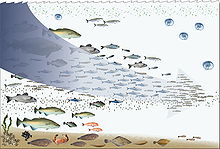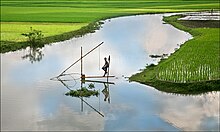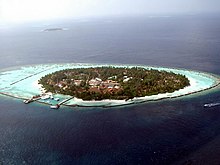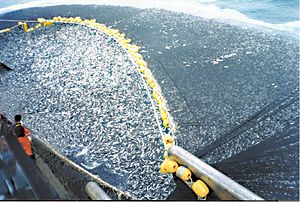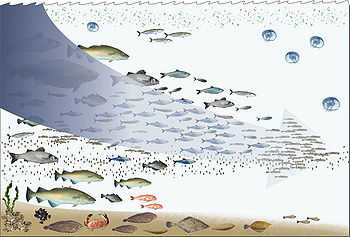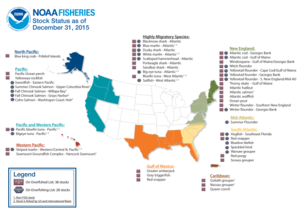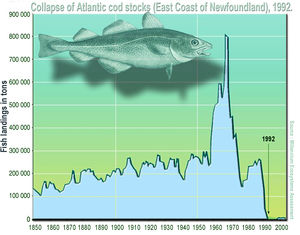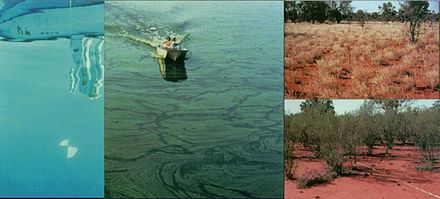SeaWiFS map showing the levels of primary production in the world's oceans
Primary
production required (PPR) to sustain global marine fisheries landings
expressed as percentage of local primary production (PP).Estimates of
PPR, PP and PPR/PP computed per 0.5° latitude/longitude ocean cells. PPR
estimates based on the [www.seaaroundus.org Sea Around Us] catch
database and PP estimates derived from SeaWiFS's global ocean colour
satellite data. The maps represent total annual landings for 1950 (top)
and 2005 (bottom). Note that PP estimates are static and derived from
the synoptic observation for 1998.
A conventional idea of a sustainable fishery is that it is one
that is harvested at a sustainable rate, where the fish population does
not decline over time because of fishing practices. Sustainability in fisheries combines theoretical disciplines, such as the population dynamics of fisheries, with practical strategies, such as avoiding overfishing through techniques such as individual fishing quotas, curtailing destructive and illegal fishing practices
by lobbying for appropriate law and policy, setting up protected areas,
restoring collapsed fisheries, incorporating all externalities involved
in harvesting marine ecosystems into fishery economics, educating
stakeholders and the wider public, and developing independent
certification programs.
Some primary concerns around sustainability are that heavy fishing pressures, such as overexploitation and growth or recruitment overfishing, will result in the loss of significant potential yield; that stock
structure will erode to the point where it loses diversity and
resilience to environmental fluctuations; that ecosystems and their
economic infrastructures will cycle between collapse and recovery; with
each cycle less productive than its predecessor; and that changes will
occur in the trophic balance (fishing down marine food webs).
Overview
Sustainable management of fisheries cannot be achieved without an acceptance that the long-term goals of fisheries management are the same as those of environmental conservation Daniel Pauly and Dave Preikshot,
Global wild fisheries are believed to have peaked and begun a decline, with valuable habitats, such as estuaries and coral reefs, in critical condition. Current aquaculture or farming of piscivorous fish, such as salmon, does not solve the problem because farmed piscivores are fed products from wild fish, such as forage fish. Salmon farming also has major negative impacts on wild salmon. Fish that occupy the higher trophic levels are less efficient sources of food energy.
Fishery ecosystems are an important subset of the wider marine environment. This article documents the views of fisheries scientists and marine conservationists about innovative approaches towards sustainable fisheries.
History
In the end, we will conserve only what we love; we will love only what we understand; and we will understand only what we are taught Senegalese conservationist Baba Dioum,
In his 1883 inaugural address to the International Fisheries Exhibition in London, Thomas Huxley
asserted that overfishing or "permanent exhaustion" was scientifically
impossible, and stated that probably "all the great sea fisheries are
inexhaustible". In reality, by 1883 marine fisheries were already collapsing. The United States Fish Commission was established 12 years earlier for the purpose of finding why fisheries in New England were declining. At the time of Huxley's address, the Atlantic halibut fishery had already collapsed (and has never recovered).
Traditional management of fisheries
Traditionally, fisheries management and the science underpinning it was distorted by its "narrow focus on target populations
and the corresponding failure to account for ecosystem effects leading
to declines of species abundance and diversity" and by perceiving the
fishing industry as "the sole legitimate user, in effect the owner, of
marine living resources." Historically, stock assessment scientists
usually worked in government laboratories and considered their work to
be providing services to the fishing industry. These scientists
dismissed conservation issues and distanced themselves from the
scientists and the science that raised the issues. This happened even as
commercial fish stocks deteriorated, and even though many governments
were signatories to binding conservation agreements.
Defining sustainability
Ray Hilborn, of the University of Washington, distinguishes three ways of defining a sustainable fishery:
- Long term constant yield is the idea that undisturbed nature establishes a steady state that changes little over time. Properly done, fishing at up to maximum sustainable yield allows nature to adjust to a new steady state, without compromising future harvests. However, this view is naive, because constancy is not an attribute of marine ecosystems, which dooms this approach. Stock abundance fluctuates naturally, changing the potential yield over short and long term periods.
- Preserving intergenerational equity acknowledges natural fluctuations and regards as unsustainable only practices which damage the genetic structure destroy habitat, or deplete stock levels to the point where rebuilding requires more than a single generation. Providing rebuilding takes only one generation, overfishing may be economically foolish, but it is not unsustainable. This definition is widely accepted.
- Maintaining a biological, social and economic system considers the health of the human ecosystem as well as the marine ecosystem. A fishery which rotates among multiple species can deplete individual stocks and still be sustainable so long as the ecosystem retains its intrinsic integrity. Such a definition might consider as sustainable fishing practices that lead to the reduction and possible extinction of some species.
Social sustainability
Fisheries
and aquaculture are, directly or indirectly, a source of livelihood for
over 500 million people, mostly in developing countries.
Social sustainability can conflict with biodiversity. A fishery
is socially sustainable if the fishery ecosystem maintains the ability
to deliver products the society can use. Major species shifts within the
ecosystem could be acceptable as long as the flow of such products
continues.
Humans have been operating such regimes for thousands of years,
transforming many ecosystems, depleting or driving to extinction many
species.
According to Hilborn, the "loss of some species, and indeed
transformation of the ecosystem is not incompatible with sustainable
harvests." For example, in recent years, barndoor skates have been caught as bycatch in the western Atlantic. Their numbers have severely declined and they will probably go extinct if these catch rates continue.
Even if the barndoor skate goes extinct, changing the ecosystem, there
could still be sustainable fishing of other commercial species.
Reconciling fisheries with conservation
Management goals might consider the impact of salmon on bear and river ecosystems
At the Fourth World Fisheries Congress in 2004, Daniel Pauly
asked, "How can fisheries science and conservation biology achieve a
reconciliation?", then answered his own question, "By accepting each
other’s
essentials: that fishing should remain a viable occupation; and that
aquatic ecosystems and their biodiversity are allowed to persist."
A relatively new concept is relationship farming. This is a way of operating farms so they restore the food chain
in their area. Re-establishing a healthy food chain can result in the
farm automatically filtering out impurities from feed water and air,
feeding its own food chain, and additionally producing high net yields
for harvesting. An example is the large cattle ranch Veta La Palma in southern Spain. Relationship farming was first made popular by Joel Salatin who created a 220 hectare relationship farm featured prominently in Michael Pollan's book The Omnivore's Dilemma (2006) and the documentary films, Food, Inc. and Fresh.
The basic concept of relationship farming is to put effort into
building a healthy food chain, and then the food chain does the hard
work.
Obstacles
Large areas of the global continental shelf, highlighted in cyan, have had heavy bottom trawls repeatedly dragged over them
Overfishing
Overfishing can be sustainable. According to Hilborn, overfishing can
be "a misallocation of societies' resources", but it does not
necessarily threaten conservation or sustainability".
Overfishing is traditionally defined as harvesting so many fish that the yield is less than it would be if fishing were reduced. For example, Pacific salmon are usually managed by trying to determine how many spawning salmon, called the "escapement",
are needed each generation to produce the maximum harvestable surplus.
The optimum escapement is that needed to reach that surplus. If the
escapement is half the optimum, then normal fishing looks like
overfishing. But this is still sustainable fishing, which could continue
indefinitely at its reduced stock numbers and yield. There is a wide
range of escapement sizes that present no threat that the stock might
collapse or that the stock structure might erode.
On the other hand, overfishing can precede severe stock depletion and fishery collapse.
Hilborn points out that continuing to exert fishing pressure while
production decreases, stock collapses and the fishery fails, is largely
"the product of institutional failure."
Today over 70% of fish species are either fully exploited,
overexploited, depleted, or recovering from depletion. If overfishing
does not decrease, it is predicted that stocks of all species currently
commercially fished for will collapse by 2048.
A Hubbert linearization (Hubbert curve) has been applied to the whaling industry, as well as charting the price of caviar, which depends on sturgeon stocks. Another example is North Sea cod.
Comparing fisheries and mineral extraction tells us that human pressure
on the environment is causing a wide range of resources to go through a
Hubbert depletion cycle.
Habitat modification
Nearly all the world’s continental shelves, and large areas of continental slopes, underwater ridges, and seamounts, have had heavy bottom trawls and dredges repeatedly dragged over their surfaces. For fifty years, governments and organizations, such as the Asian Development Bank, have encouraged the fishing industry to develop trawler fleets. Repeated bottom trawling and dredging literally flattens diversity in the benthic habitat, radically changing the associated communities.
Changing the ecosystem balance
Since 1950, 90 percent of 25 species of big predator fish have gone.
- How we are emptying our seas, The Sunday Times, May 10, 2009.
- Pauly, Daniel (2004) Reconciling Fisheries with Conservation: the Challenge of Managing Aquatic Ecosystems Fourth World Fisheries Congress, Vancouver, 2004.
Climate change
Rising ocean temperatures and ocean acidification are radically [DJS -- radically?] altering aquatic ecosystems. Climate change is modifying fish distribution
and the productivity of marine and freshwater species. This reduces
sustainable catch levels across many habitats, puts pressure on
resources needed for aquaculture, on the communities that depend on fisheries, and on the oceans' ability to capture and store carbon (biological pump). Sea level rise puts coastal fishing communities at risk, while changing rainfall patterns and water use impact on inland (freshwater) fisheries and aquaculture.
Ocean pollution
A recent survey of global ocean health concluded that all parts of
the ocean have been impacted by human development and that 41 percent
has been fouled with human polluted runoff, overfishing, and other abuses. Pollution is not easy to fix, because pollution sources are so dispersed, and are built into the economic systems we depend on.
The United Nations Environment Programme (UNEP) mapped the impacts of stressors such as climate change, pollution, exotic species, and over-exploitation of resources on the oceans. The report shows at least 75 percent of the world's key fishing grounds may be affected.
Diseases and toxins
Large predator fish can contain significant amounts of mercury, a neurotoxin which can affect fetal development, memory, mental focus, and produce tremors.
Irrigation
Abandoned ship near Aral, Kazakhstan.
Lakes are dependent on the inflow of water from its drainage basin.
In some areas, aggressive irrigation has caused this inflow to decrease
significantly, causing water depletion and a shrinking of the lake. The
most notable example is the Aral Sea, formerly among the four largest lakes in the world, now only a tenth of its former surface area.
Remediation
Fisheries management
Fisheries management draws on fisheries science
to enable sustainable exploitation. Modern fisheries management is
often defined as mandatory rules based on concrete objectives and a mix
of management techniques, enforced by a monitoring control and surveillance system.
- Ideas and rules: Economist Paul Romer believes sustainable growth is possible providing the right ideas (technology) are combined with the right rules, rather than simply hectoring fishers. There has been no lack of innovative ideas about how to harvest fish. He characterizes failures as primarily failures to apply appropriate rules.
- Fishing subsidies: Government subsidies influence many of the world fisheries. Operating cost subsidies allow European and Asian fishing fleets to fish in distant waters, such as West Africa. Many experts reject fishing subsidies and advocate restructuring incentives globally to help struggling fisheries recover.
- Economics: Another focus of conservationists is on curtailing detrimental human activities by improving fisheries' market structure with techniques such as salable fishing quotas, like those set up by the Northwest Atlantic Fisheries Organization, or laws such as those listed below.
- Valorization of by-catch: helping to avoid discards (and their associated adverse ecological impacts) by valorizing by-catch products, as they are good sources for protein hydrolizates, peptones, enzymatic mixtures or fish oil being these products of interest different industrial sectors.
- Payment for Ecosystem Services: Environmental Economist, Essam Y Mohammed, argues that by creating direct economic incentives, whereby people are able to receive payment for the services their property provides, will help to establish sustainable fisheries around the world as well as inspire conservation where it otherwise would not.
- Sustainable fisheries certification: A promising direction is the independent certification programs for sustainable fisheries conducted by organizations such as the Marine Stewardship Council and Friend of the Sea. These programs work at raising consumer awareness and insight into the nature of their seafood purchases.
- Ecosystem based fisheries: See next section
Ecosystem based fisheries
We propose that rebuilding ecosystems, and not sustainability per se, should be the goal of fishery management. Sustainability is a deceptive goal because human harvesting of fish leads to a progressive simplification of ecosystems in favour of smaller, high turnover, lower trophic level fish species that are adapted to withstand disturbance and habitat degradation. Tony Pitcher and Daniel Pauly,
According to marine ecologist Chris Frid, the fishing industry points to marine pollution and global warming as the causes of recent, unprecedented declines in fish populations. Frid counters that overfishing has also altered the way the ecosystem
works. "Everybody would like to see the rebuilding of fish stocks and
this can only be achieved if we understand all of the influences, human
and natural, on fish dynamics.” He adds: “fish communities can be
altered in a number of ways, for example they can decrease if
particular-sized individuals of a species are targeted, as this affects predator and prey dynamics. Fishing, however, is not the sole cause of changes to marine life—pollution
is another example....No one factor operates in isolation and
components of the ecosystem respond differently to each individual
factor."
The traditional approach to fisheries science and management has
been to focus on a single species. This can be contrasted with the ecosystem-based approach. Ecosystem-based fishery concepts have been implemented in some regions.
In a 2007 effort to "stimulate much needed discussion" and "clarify the
essential components" of ecosystem-based fisheries science, a group of
scientists offered the following ten commandments for ecosystem-based fisheries scientists:
- Keep a perspective that is holistic, risk-adverse and adaptive.
- Maintain an “old growth” structure in fish populations, since big, old and fat female fish have been shown to be the best spawners, but are also susceptible to overfishing.
- Characterize and maintain the natural spatial structure of fish stocks, so that management boundaries match natural boundaries in the sea.
- Monitor and maintain seafloor habitats to make sure fish have food and shelter.
- Maintain resilient ecosystems that are able to withstand occasional shocks.
- Identify and maintain critical food-web connections, including predators and forage species.
- Adapt to ecosystem changes through time, both short-term and on longer cycles of decades or centuries, including global climate change.
- Account for evolutionary changes caused by fishing, which tends to remove large, older fish.
- Include the actions of humans and their social and economic systems in all ecological equations.
Marine protected areas
Strategies and techniques for marine conservation tend to combine
theoretical disciplines, such as population biology, with practical
conservation strategies, such as setting up protected areas, as with Marine Protected Areas (MPAs) or Voluntary Marine Conservation Areas.
Each nation defines MPAs independently, but they commonly involve
increased protection for the area from fishing and other threats.
Marine life is not evenly distributed in the oceans. Most of the
really valuable ecosystems are in relatively shallow coastal waters,
above or near the continental shelf, where the sunlit waters are often nutrient rich from land runoff or upwellings
at the continental edge, allowing photosynthesis, which energizes the
lowest trophic levels. In the 1970s, for reasons more to do with oil drilling
than with fishing, the U.S. extended its jurisdiction, then 12 miles
from the coast, to 200 miles. This made huge shelf areas part of its
territory. Other nations followed, extending national control to what
became known as the exclusive economic zone
(EEZ). This move has had many implications for fisheries conservation,
since it means that most of the most productive maritime ecosystems are
now under national jurisdictions, opening possibilities for protecting
these ecosystems by passing appropriate laws.
Daniel Pauly
characterises marine protected areas as "a conservation tool of
revolutionary importance that is being incorporated into the fisheries
mainstream." The Pew Charitable Trusts have funded various initiatives aimed at encouraging the development of MPAs and other ocean conservation measures.
Fish farming
There exists concerns that farmed fish
cannot produce necessary yields efficiently. For example, farmed salmon
eat three pounds of wild fish to produce one pound of salmon.
Laws and treaties
International laws and treaties related to marine conservation include the 1966 Convention on Fishing and Conservation of Living Resources of the High Seas. United States laws related to marine conservation include the 1972 Marine Mammal Protection Act, as well as the 1972 Marine Protection, Research and Sanctuaries Act which established the National Marine Sanctuaries program. Magnuson-Stevens Fishery Conservation and Management Act.
Awareness campaigns
Various organizations promote sustainable fishing strategies, educate
the public and stakeholders, and lobby for conservation law and policy.
The list includes the Marine Conservation Biology Institute and Blue Frontier Campaign in the U.S., The U.K.'s Frontier (the Society for Environmental Exploration) and Marine Conservation Society, Australian Marine Conservation Society, International Council for the Exploration of the Sea (ICES), Langkawi Declaration, Oceana, PROFISH, and the Sea Around Us Project, International Collective in Support of Fishworkers, World Forum of Fish Harvesters and Fish Workers, Frozen at Sea Fillets Association and CEDO.
The United Nations Millennium Development Goals include, as goal #7: target 2, the intention to "reduce biodiversity loss,
achieving, by 2010, a significant reduction in the rate of loss",
including improving fisheries management to reduce depletion of fish
stocks.
Some organizations certify fishing industry players for sustainable or good practices, such as the Marine Stewardship Council and Friend of the Sea.
Other organizations offer advice to members of the public who eat
with an eye to sustainability. According to the marine conservation
biologist Callum Roberts, four criteria apply when choosing seafood:
- Is the species in trouble in the wild where the animals were caught?
- Does fishing for the species damage ocean habitats?
- Is there a large amount of bycatch taken with the target species?
- Does the fishery have a problem with discards—generally, undersized animals caught and thrown away because their market value is low?
The following organizations have download links for wallet-sized cards, listing good and bad choices:
- Monterey Bay Aquarium Seafood Watch, USA
- Blue Ocean Institute, USA
- Marine Conservation Society, UK
- Australian Marine Conservation Society
- The Southern African Sustainable Seafood Initiative
Data issues
Data quality
One
of the major impediments to the rational control of marine resources is
inadequate data. According to fisheries scientist Milo Adkison (2007),
the primary limitation in fisheries management decisions is poor data.
Fisheries management decisions are often based on population models, but
the models need quality data to be accurate. Scientists and fishery
managers would be better served with simpler models and improved data.
Unreported fishing
Estimates of illegal catch losses range between $10 billion and $23 billion annually, representing between 11 and 26 million tonnes.
Shifting baselines
Shifting baselines
is the way significant changes to a system are measured against
previous baselines, which themselves may represent significant changes
from the original state of the system. The term was first used by the fisheries scientist Daniel Pauly in his paper "Anecdotes and the shifting baseline syndrome of fisheries". Pauly developed the term in reference to fisheries management where fisheries scientists sometimes fail to identify the correct "baseline" population size (e.g. how abundant a fish species population was before human exploitation) and thus work with a shifted baseline.
He describes the way that radically depleted fisheries were evaluated
by experts who used the state of the fishery at the start of their
careers as the baseline, rather than the fishery in its untouched state.
Areas that swarmed with a particular species hundreds of years ago, may
have experienced long term decline, but it is the level of decades
previously that is considered the appropriate reference point for
current populations. In this way large declines in ecosystems or species
over long periods of time were, and are, masked. There is a loss of perception of change that occurs when each generation redefines what is "natural".
Looting the seas
Looting the seas is the name given by the International Consortium of Investigative Journalists
to a series of journalistic investigations into areas directly
affecting the sustainability of fisheries. So far they have investigated
three areas involving fraud, negligence and overfishing:
- The black market in bluefin tuna
- Subsidies propping up the Spanish fishing industry
- Overfishing of the southern jack mackerel
Other factors
The
focus of sustainable fishing is often on the fish. Other factors are
sometimes included in the broader question of sustainability. The use
of non-renewable resources is not fully sustainable. This might include diesel fuel for the fishing ships and boats: there is even a debate about the long term sustainability of biofuels. Modern fishing nets are usually made of artificial polyamides like nylon. Synthetic braided ropes
are generally made from nylon, polyester, polypropylene or high
performance fibers such as high modulus polyethylene (HMPE) and aramid.
Energy and resources are employed in fish processing, refrigeration, packaging, logistics, etc. The methodologies of Life-cycle assessment are useful to evaluate the sustainability of components and systems. These are part of the broad question of sustainability.




